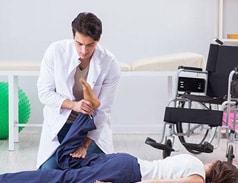I’m Shelley from Miami Physiotherapy and I’m going to explain lumbar spinal central stenosis and give you some management tips.
What is lumbar spinal stenosis?
Lumbar Spinal stenosis is the narrowing of the central spinal canal. In your spine there is the bony central canal where your spinal cord sits. Now as you get older you get a bit of degeneration in your spinal – this can be facet joint degeneration (wear and tear), disc degeneration, calcification of the spinal ligaments, the formation of spurs – lots of contributing factors – that ultimately can cause a narrowing of the spinal canal.
The natural curve of the spine, the shape of the vertebrae in the different sections and the increased thickness of the spinal cord at different levels means that naturally when you are standing upright, and your low back is relatively extended, there is less natural space available in the lumbar spinal canal. Normally this is fine, and your spinal cord is perfectly happy. But if you have some narrowing – some stenosis – then being in this position can actually cause pressure on your spinal cord.
Keep watching to learn the symptoms that are associated with lumbar spinal stenosis.
It’s important to note that you can have narrowing of the central canal show up on a scan, but have no symptoms. The term spinal stenosis refers to the painful symptoms associated with the narrowing, not the narrowing itself. The symptoms patients often report are a combination of low back pain, leg pain – either one or both legs, numbness, tingling, and weakness. The main difference in lumbar spinal stenosis symptoms and other causes of low back pain is that symptoms are worse when the person is upright and especially walking. Symptoms get worse with walking and are relieved by bending forward or sitting down.
Walking up stairs or uphill can be less painful, as you generally lean forward when walking up stairs or hills.
Does this sound like you, or someone you know? Keep watching to learn some tips to manage painful spinal stenosis.
Managing lumbar spinal stenosis
As I’ve hinted at – flexion – or bending positions of the spine make more space in the central canal and therefore relieve the pressure on the spine. So these positions can be used to help manage this painful condition. Try these things to help manage your pain:
- Lean on a trolley if you are at the shops
- Lean on a walking stick or hiking stick when walking
- When walking, take breaks and sit to ease your symptoms, or lean forward with your hands on your knees.
- In bed, try sleeping on your side with your knees bent up.
If you get relief from these tips, it’s important to come and have a thorough physio assessment. We can determine whether you require further investigations as part of your management, and whether conservative physiotherapy treatment will help you. From a physiotherapy treatment viewpoint – we can work on your posture, your core strength, your spinal movement patterns and teach you exercises to maximise your function and minimize your symptoms. If this is something that you would like us to assess, give us a call.

